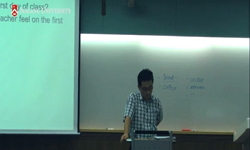By using the methodological framework of conversation analysis, this study combines a grounded study of interactional linguistics focusing on L2 speakers' interactional competence in the use of Korean sentence-ending suffix -ketun. Based on the previo...
http://chineseinput.net/에서 pinyin(병음)방식으로 중국어를 변환할 수 있습니다.
변환된 중국어를 복사하여 사용하시면 됩니다.
- 中文 을 입력하시려면 zhongwen을 입력하시고 space를누르시면됩니다.
- 北京 을 입력하시려면 beijing을 입력하시고 space를 누르시면 됩니다.
https://www.riss.kr/link?id=A105797876
- 저자
- 발행기관
- 학술지명
- 권호사항
-
발행연도
2014
-
작성언어
-
- 주제어
-
KDC
701
-
등재정보
KCI등재
-
자료형태
학술저널
- 발행기관 URL
-
수록면
23-60(38쪽)
- 제공처
-
0
상세조회 -
0
다운로드
부가정보
다국어 초록 (Multilingual Abstract)
By using the methodological framework of conversation analysis, this study combines a grounded study of interactional linguistics focusing on L2 speakers' interactional competence in the use of Korean sentence-ending suffix -ketun. Based on the previous studies which examined the use of -ketun. in L1 Korean speakers' conversation, this study analyzes data taken from different levels of Korean language classroom interactions, with close attention to the learner's usage of the target suffix in formulating a dispreferred response. The findings of the study demonstrate that the L2 advanced students' use of -ketun is much closer to that for L1 speakers in constituting a dispreferred response while claiming epistemic primacy. On the other hand, extremely low frequency in the use of -ketun is a distinctive linguistic-pragmatic features that characterizes use of -ketun by L2 speakers at lower levels of competence. The advanced students' diversification may be an indicator of their more adaptive, con text- sensitive conduct, suggesting an increased interactional competence. Close scrutiny of the use of -ketun in this study aids to reveal whether and to what extent its interactional use by L2 speakers of different proficiency levels approaches that of L1 speakers.
목차 (Table of Contents)
- Abstract
- Ⅰ. Introduction
- Ⅱ. Background
- Ⅲ. Data and Methods
- Ⅳ. Findings
- Abstract
- Ⅰ. Introduction
- Ⅱ. Background
- Ⅲ. Data and Methods
- Ⅳ. Findings
- Ⅴ. Discussion and Conclusion
- References
동일학술지(권/호) 다른 논문
-
- 한국사회언어학회
- 강희숙(Kang Hui-suk)
- 2014
- KCI등재
-
- 한국사회언어학회
- 김현강(Kim Hyun-kang)
- 2014
- KCI등재
-
- 한국사회언어학회
- 박혜경(Park Hai-kyong)
- 2014
- KCI등재
-
국어과 예비교사 수업 시연의 언어ㆍ행동 평가 기준안 마련을 위한 기초 연구
- 한국사회언어학회
- 신호철(Shin Ho-cheol)
- 2014
- KCI등재





 스콜라
스콜라


